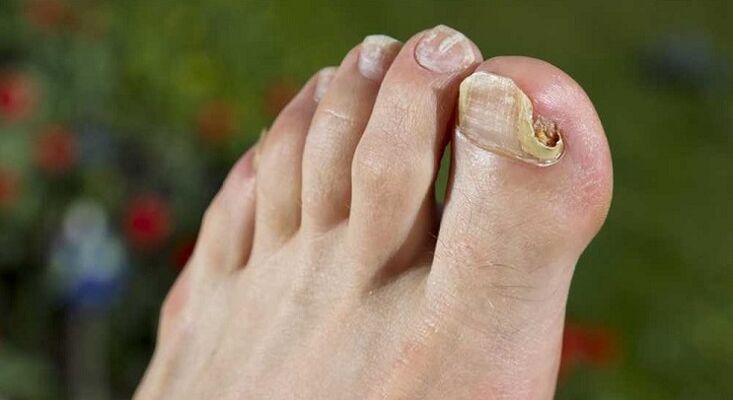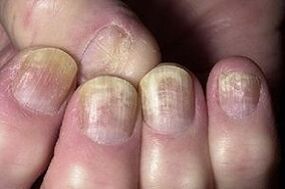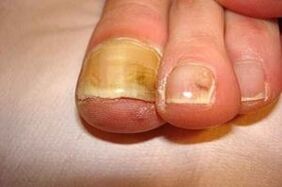Not everyone knows what a fungus looks like and can initially identify this disease and start treatment. Itching, redness, peeling and cracking are all signs of this condition. However, there are other diseases with similar symptoms, such as eczema or psoriasis. And even nails can change their appearance not due to a fungal infection, but due to psychological stress or many diseases of the internal organs. So the final diagnosis can only be made by a doctor after receiving the test results. It is the patient’s job to alert their doctor in a timely manner if warning signs appear.

The main symptoms of mycoses
The characteristic symptoms of foot mycosis are peeling, and most often in the form of rings or plates of a certain shape. Sometimes it is so insignificant that such a situation can last for months, if not years, but at the same time does not cause much inconvenience. However, some people try to overcome such manifestations of mycosis on their own. Folk remedies like iodine, vinegar and bright green are used and for a while the disease really disappears. More specifically, it seems, but in fact, this treatment leads to the fungus on the legs simply freezing and then continuing to multiply in a more favorable position.
Moreover, if at an early stage such a disease is not completely cured but only the symptoms are removed, it spreads very quickly to the nails and smooth skin. Not to mention that other family members can also infect the fungal disease.
<2_img_rxx>The extent of the change in mycosis of the foot depends on a number of factors. If there are preconditions such as microtrauma, various pathologies of the endocrine system, diabetes mellitus, if a person undergoes certain treatment with glucocorticoids or cytostatics, all this contributes to the further development of the disease.
One day, the period of relative stability comes to an end and the patient sees not the most attractive picture - it’s not just peeling of the skin, but bubbles, crying cracks in the leg, getting out. These are all classic symptoms that occur in the later stages of pathology development. However, the initial stage of the nail fungus is visible. Although the type of microorganisms can only be examined in more detail under a microscope, their activity is much more noticeable - this is a change in the shape and color of the nails, followed by their thickening and destruction.
Mushroom on the nails and its manifestations
The elasticity of the nails is manifested in different ways. It all depends on the stage of the disease and what fungus is the cause. Normally, the nail should be smooth, pink and evenly shiny. If the condition of the nails is far from the described ideal, then something happens to the body.
The nails grow at a certain rate. When a person is under stress, this ratio decreases and the nail becomes thinner and weaker. The body then normalizes and the nails return to their original state in terms of growth indices, but this weak stripe on the nail plate remains. And if a person’s life is quite nervous, there can be several such streaks. In addition, onychomycosis (and this is the scientific name for nail fungus) is not the only disease that leads to a change in the color or shape of the nail plate. Pathologies such as immune deficiency, hormonal imbalance, and other disorders of the endocrine system lead to exactly the same results. It is therefore necessary to carry out an analysis on a case-by-case basis.
The appearance of the fungus depends largely on which microorganisms caused the onychomycosis. And several types can provoke you. For example, when we talk about dermatophytes, the fungus looks exactly like a cloud of nails. This is a manifestation of the initial stage of the fungus. After that, yellow spots may appear on the edge of the disc or even in the middle of it. Longitudinal streaks then appear and the nail collapses.
Otherwise, yeast problems will appear. In such cases, the nail plate becomes noticeably thinner, acquires a grayish tinge, and after a while it deviates from its normal position. This is largely due to the deterioration of metabolism in damaged cells. However, the grooves that appear on the fold of the nail eventually confirm the diagnosis - yeast.
Mold should be mentioned separately. It usually only affects the nail plate, making it cloudy and discolored; it can be light yellow, greenish, brown and even black.
The peculiarity of these fungi is that they only cause surface damage and do not penetrate deep inside.
Obviously, the diagnosis can only be made by the treating physician, who will consider all the symptoms and perform the tests. Self-medication without consulting a doctor has very unpleasant consequences.
Stages and types of onychomycosis

Considering the stages of onychomycosis, many confuse these with the types of disease, of which there are three. It is normotrophic, hypertrophic and atrophic onychomycosis.
For example, in normotrophic onichomycosis, the nail changes color, streaks and spots may appear on it, but its thickness and gloss remain normal. Many people think that this is a nail fungus, the initial stage of which develops into a more serious pathology, but in fact in such situations the fungus responds well to treatment.
In the case of hypotrophic onichomycosis, the color of the nail changes, its light is lost, the nail itself thickens and deforms, and in some cases even breaks down along the edges. Onicholytic species are often referred to as atrophy. This is not the same nail fungus whose initial stage is expressed by cracks and discoloration, here the treatment will be different as the affected part of the plate is atrophic.
Treatment of foot and nail mycosis
The first thing with this disease is to see a doctor who will help you choose a medicine that meets the following requirements:
- high antifungal activity, which allows to fight against different types of infectious agents;
- a sufficiently high concentration of the active substance both in the preparation itself and in the surface layers of the skin after application;
- complex antifungal and antibacterial therapy;
- no contraindications and side effects, including allergic reactions;
- easy use.
Given these needs, it is not surprising that the stage of drug selection is so important. As a general rule, drugs based on substances such as cyclopirox and naftifin are used in the absence of complications. Ointments, less commonly tablets, are prepared. In the more severe stages of mycosis, treatment with terbinafine and fluconazole-based drugs is recommended.
Tablets should be taken if ointments and creams intended for external use have not worked. The dosage of the tablets should be checked with your doctor. Usually, all of these are fairly powerful treatments, so the treatment process takes about 7-10 days, although there are medications that can be taken for up to 3-4 weeks.
The doctor prescribing such therapy will take into account what other medications the patient will be taking. These medications can be a side effect of vomiting or dizziness. We consider this to be valid. Generic drugs are milder than the originals, but their effect is small.
Operational interventions
In previously advanced cases, surgical removal of the affected tissue has been practiced. This is especially true for nails. Now they use a drill like the one used in the dental office. Even in the most advanced cases, it takes about half an hour to cut almost all the nails. And if the problem is with only one affected nail, it only takes about 5 minutes.

No further precautions are required after the procedure. This procedure does not cause painful feelings, you can lead a normal lifestyle, you can do a morning jog. It is only necessary to ensure that the affected areas of the skin are not damaged.
Treatment of the nails with such a treatment is not enough, however, it should be repeated at least once more, 3-4 weeks after the first treatment, when the nails grow slightly. You usually have to tune in to the fact that this process is long, it can take a month, and if things have gone far enough, it can take several months. For example, there are cases where in the first 3-4 months, the patient performs nail treatment with such a device every 2-3 weeks and then takes medication for several months.
Are folk remedies effective?
Any doctor says that prescriptions for traditional medicine are ineffective or even harmful for such a disease. First, neither vinegar nor herbs, or even honey, despite its antiseptics, have virtually no effect on the fungus. Yes, you can hear from your friends that some of these recipes have helped you get rid of itching or cracking. Well, then these signs were simply not attributed to the fungus. The same psoriasis or eczema has similar symptoms and is treated perfectly with the above folk methods.
Second, these drugs help to eliminate the signs of the fungus, that is, they cover it up for a while, and that’s enough to get everyone in the family infected.
However, the vinegar mentioned above will also be effective for other purposes - it can be used to wash bedding and shoes to prevent the fungus from re-infecting. The only shoe that isn’t washed but thrown away is home slippers because it can’t be disinfected. Vinegar can also be used to disinfect the bathtub.






























